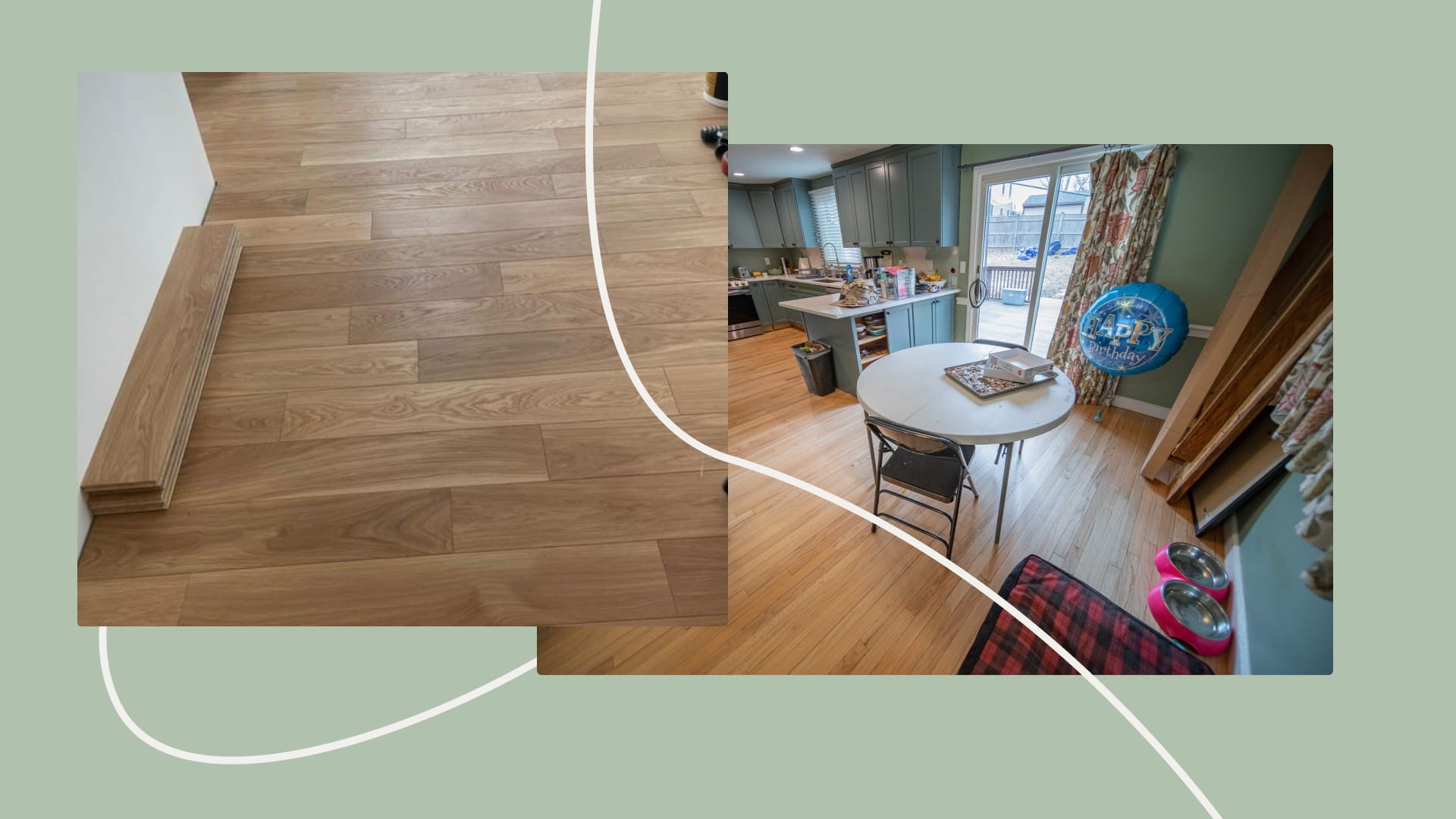Updated: February 21, 2025
So you're standing at a crossroads and asking yourself, “Should I replace my hardwood floors with laminate?” You are not alone. This issue worries many homeowners, especially when old wood begins to make itself felt, or when the budget is not enough for a complete upgrade. The fact is that both options have their advantages. You just need to weigh them all.
Let's look at this in more detail.
Key Considerations Before Making the Switch
1. Aesthetic Appeal
Hardwood floors have an eternal appeal. They add warmth, depth and richness that laminate simply cannot match. Whether it's classic oak, sturdy maple, or deep cherry tones, the hardwood tells a story. Each board is unique. The texture. Grain size. It's a signature that never disappears, no matter how much time passes.
But laminate flooring? It's not the same, at least not in this form. Of course, the new, high-quality versions look pretty convincing from afar. But close up? You will see this brilliance. That sleek, industrial look. It's good, don't get me wrong, but it doesn't breathe the same life as a real tree.
Verdict: If you need a floor that feels like part of the space — authentic and durable, choose hardwood. But if your goal is an inexpensive option that will look great from a distance and won't cost much? Laminate flooring is still doing a great job.
2. Durability
Let's talk about durability. With proper care, the wood board will last for decades and even centuries. And those scuffs and scratches? You can sand them, polish the boards, and boom! Your floor will be as good as new. The hardwood board is a long-term commitment. And if you take care of him, he will repay you by remaining amazing for years to come.
The laminate, however, does not bend. It's durable. It resists scratches, dents and stains. He handles the mess that pets and children make without batting an eye. But here's the catch: as soon as it wears out, everything is ready. No sanding required. No re-polishing required. When she disappears, she won't be there. The shelf life of laminate is 10-15 years, give or take. After that, it will be time for a complete replacement.
Verdict: if you want the floor to grow with you, choose a hardwood floors. If you need something that can withstand shocks and does not require special care, then laminate flooring is what you need.
3. Cost
Now let's talk about money. Hardwood is not cheap. At a minimum, the cost of materials ranges from $4 to $8 per square foot. And let's not forget about the cost of hardwood floor installation — it's not a DIY project unless you're really ready to roll up your sleeves. Hardwood professionals often charge a lot of money, especially if you are going to lay an unfinished route that requires polishing and fine-tuning.
In addition, there is laminate flooring. The price of it dramatically changes the situation. Laminate flooring costs only $1 per square foot, and it can simply be stolen. But what about the styling? It's not difficult at all. You can even do it yourself with this simple click-lock system. No glue, no mess. Just glue these boards in place.
Verdict: laminate wins in the budget game. But if you're looking for a high-quality look that will stand the test of time, then hardwood flooring won't come cheap, although it will pay off with a vengeance.
4. Installation
Hardwood floors? The whole project. Most likely, you will need professional installation assistance. This is not a job that is easy to do on your own, especially if you are working with raw boards. Sanding, coloring, finishing is a multi—day process. And it's worth it, but it takes a lot of time and effort.
Laminate flooring? This dramatically changes the situation. Thanks to the floating locking system, you don't need a professional. In fact, you could probably do it yourself in a day, even if you've never picked up a hammer. It's fast, painless, and perfect for DIY enthusiasts.
Verdict: Do you want a quick and easy styling? Laminate flooring is your friend. But if you're willing to spend time and effort (or pay someone for it), then it's best to use hardwood.
5. Water Resistance
Here's the thing: hardwoods don't mix well with water. Everything is very simple. Moisture can cause deformation, swelling and discoloration of hardwood. If you are thinking about installing hardwood in the bathroom or basement? Think again about where NOT to install hardwood floors. If you don't have a serious humidity control system, this is not the best choice.
Laminate, however, is a more gentle material. Of course, it is not 100% waterproof, but it can withstand accidental spills or high humidity. The kitchen? The basement? Laminate flooring will protect you. Just remember that it is not resistant to water over time.
Verdict: Do you need something that handles moisture better? Laminate flooring is your choice for kitchens, bathrooms and basements.
6. Resale Value
That's where the fun begins. The wood board is not only what it looks like today. It is important that it brings your home in the long run. Hardwood floors are an investment. Real estate experts claim that hardwood flooring can increase a home’s value by up to 2.5% to 10%, or offer an ROI of 70-147% on installation costs, depending on the specific project and market (Realtor.com, National Wood Flooring Association, National Association of Realtors). Customers like it. It's luxurious, it's classic — it adds extra benefits to your home.
Laminate flooring? It won't add anywhere near that much value. Although it may look beautiful, buyers tend to view it as a temporary solution — especially compared to the appeal of hardwood. It doesn't have the same wow factor.
Verdict: Do you want to increase the value of your home? Choose hardwoods. If you're just looking for a functional floor that won't cost much, laminate flooring is perfect.
7. Damage Factor
Many homeowners turn to laminate flooring when hardwood floors are subject to damage such as warping, scratches, dents, or gaps. But does it always need to be replaced? Is it possible to restore hardwood floors?
Damaged Hardwood: Due to water damage, gaps and deep scratches, it may seem that replacement is the only way out. Water can cause swelling, deformation, and warping, especially if left untreated. Gaps occur when wood expands and contracts as humidity changes. Scratches and dents? It is common, especially in homes with heavy traffic or with pets.
Is it possible to repair a hardwood floors? Most of the time, yes. Gaps can be fixed, scratches can be sanded, and minor water damage can be repaired by drying and polishing. However, if the damage is extensive, you may need a full refinishing of hardwood floors or even a complete replacement.
Damaged Laminate: The laminate cannot be repaired after damage. Scratches, dents, or warping require a complete replacement of the board. However, laminate is initially more durable and less susceptible to damage.
Which is better? If your hardwood is severely damaged — warped or badly scratched — and repair is no longer possible, laminate flooring can be an economical solution. But if the damage is minor and you value natural wood, repairs or refinishes are probably the best choice.
Hardwood vs Laminate Flooring: A Quick Comparison
Here’s a simplified comparison between hardwood and laminate flooring based on key factors. Use this to help decide which option fits your needs best!
| Factor | Hardwood Flooring | Laminate Flooring |
|---|---|---|
| Aesthetic Appeal | 🌟 Better | ❌ Worse |
| Durability | 🌟 Better | ⚖️ Average |
| Cost | ❌ Worse | 🌟 Better |
| Installation | ❌ Worse | 🌟 Better |
| Water Resistance | ⚖️ Average | 🌟 Better |
| Resale Value | 🌟 Better | ❌ Worse |
| Damage Factor | 🌟 Better | ❌ Worse |
In summary, hardwood flooring excels in aesthetics, durability, resale value, and damage repairability. However, laminate is the more affordable, easier-to-install, and water-resistant option. The best choice depends on your priorities!



